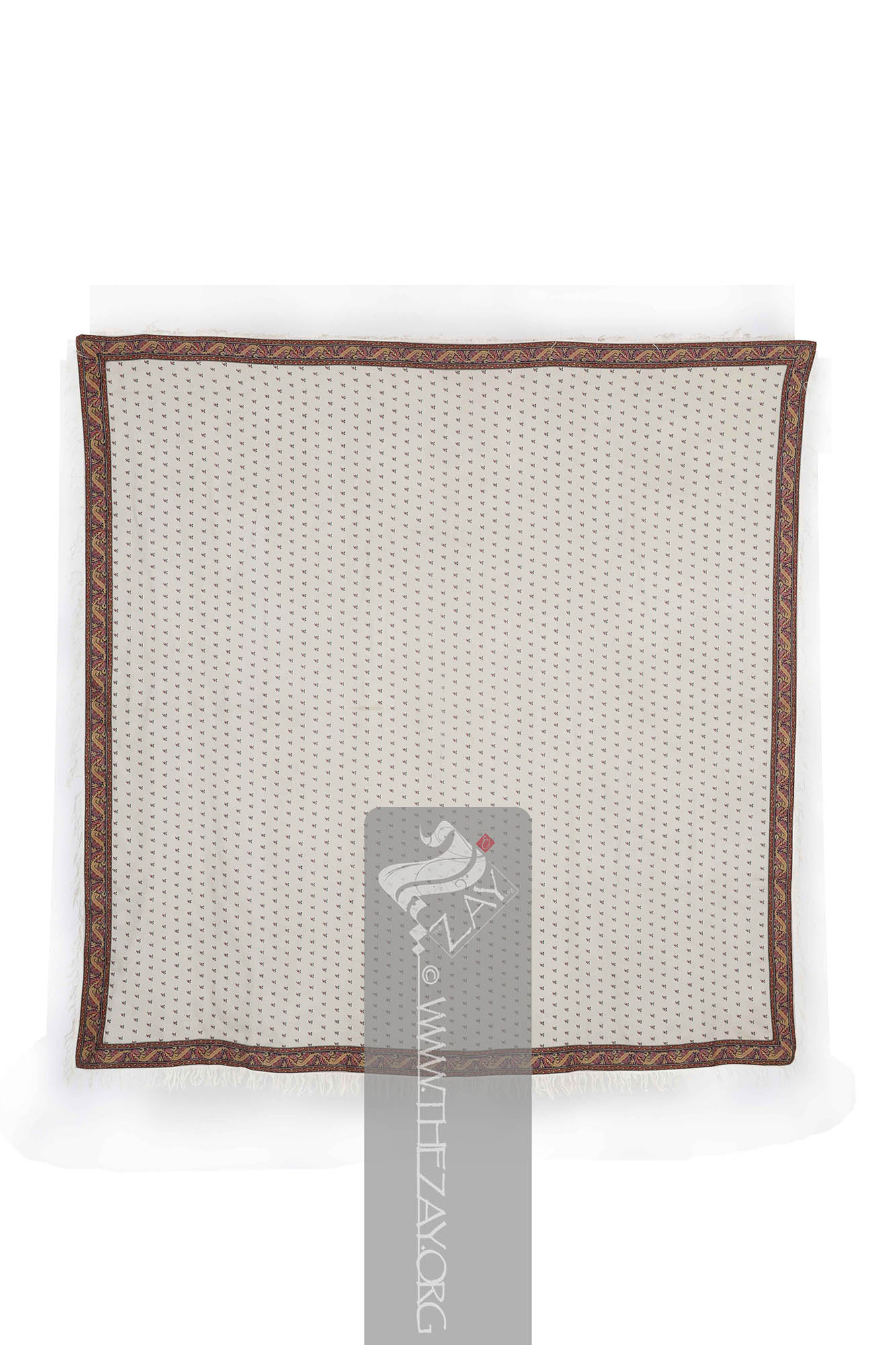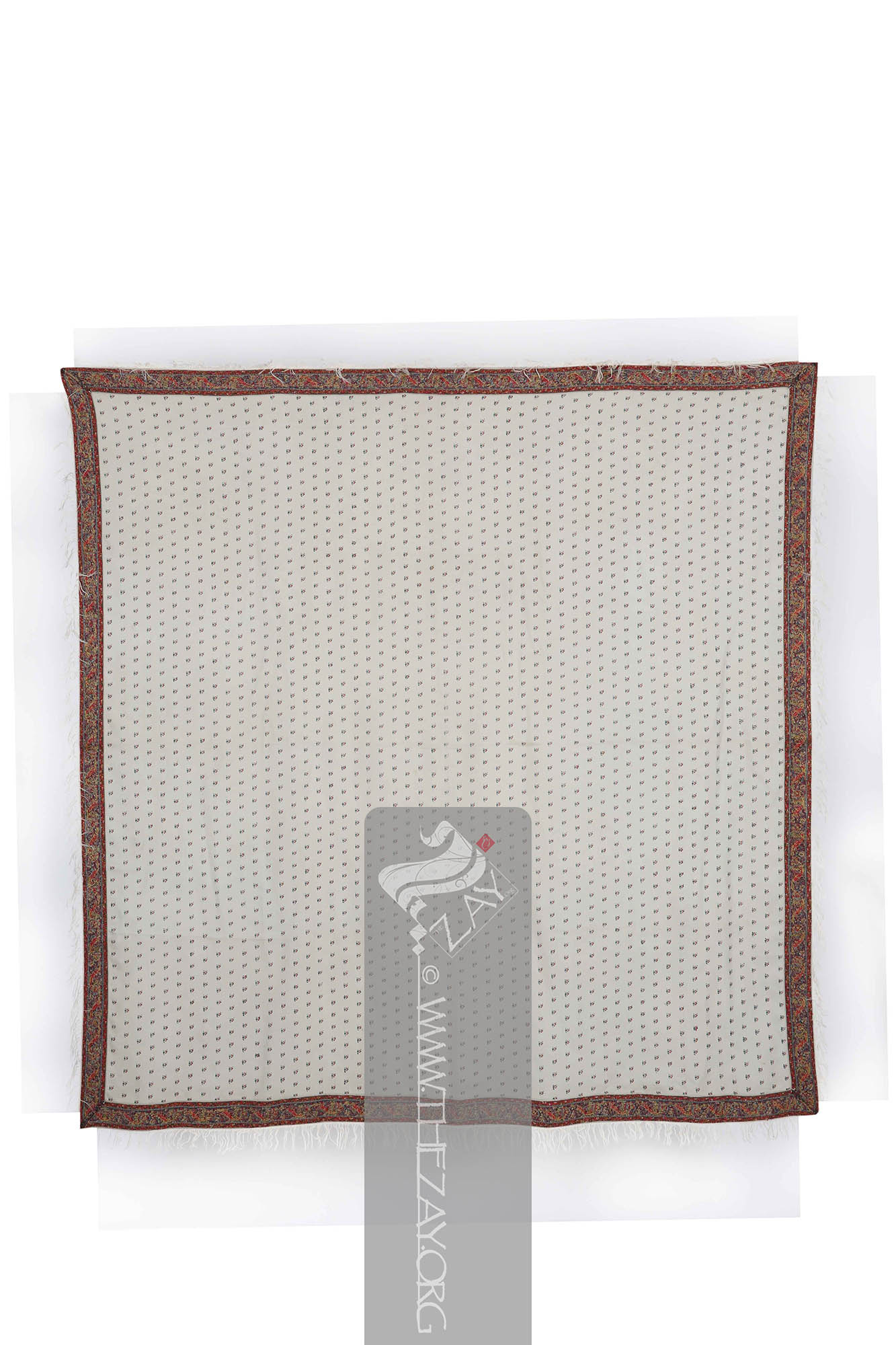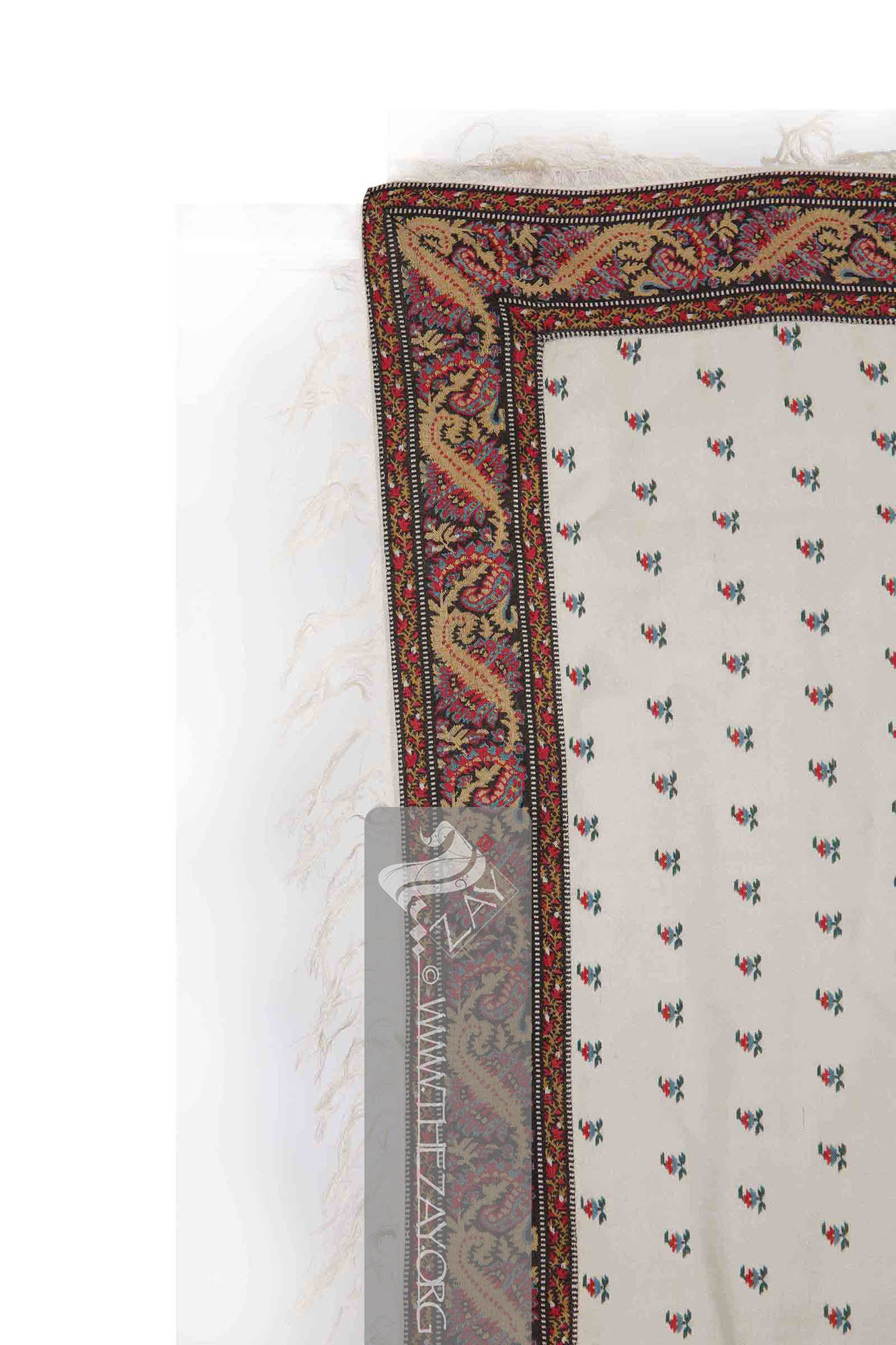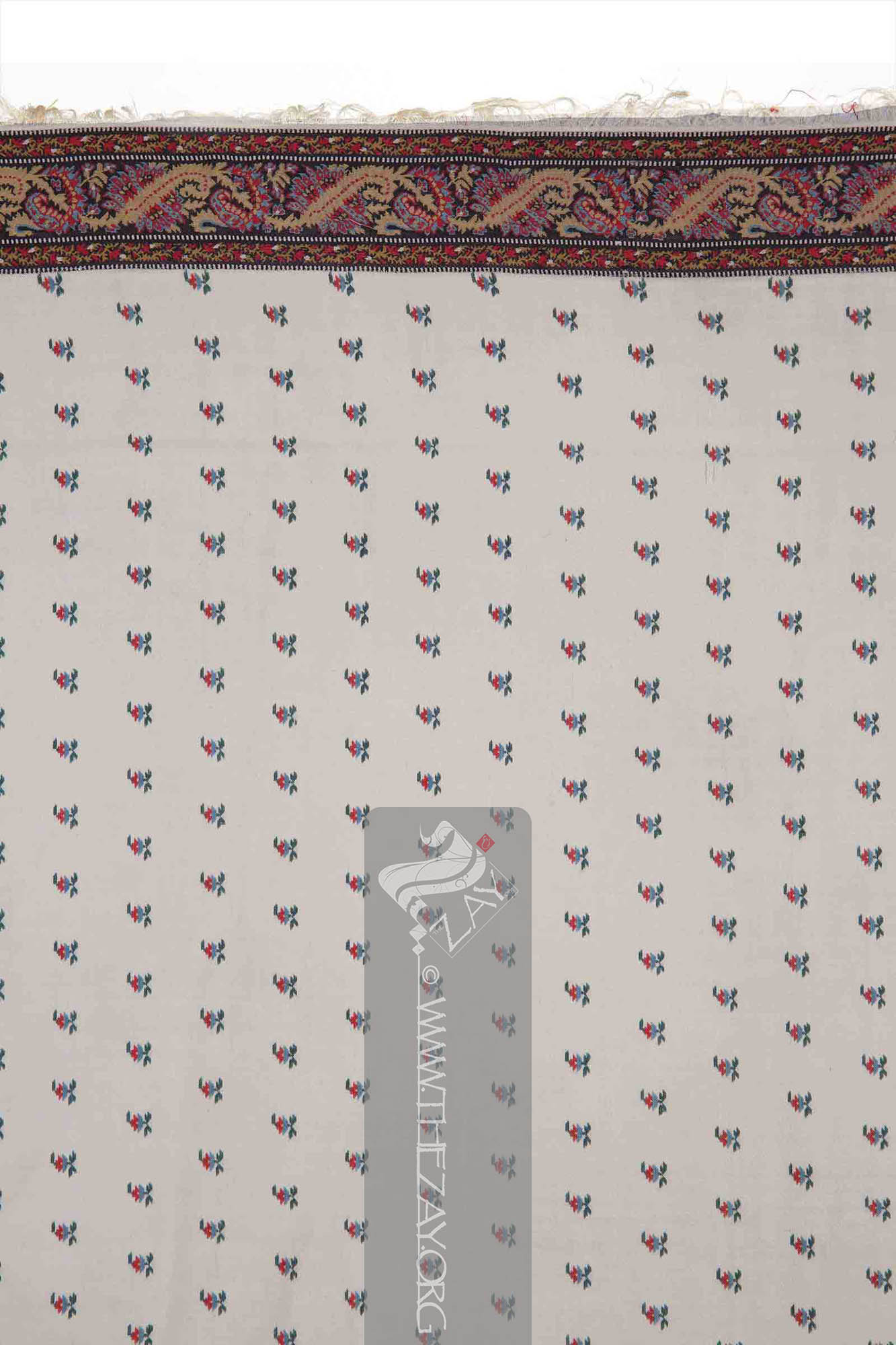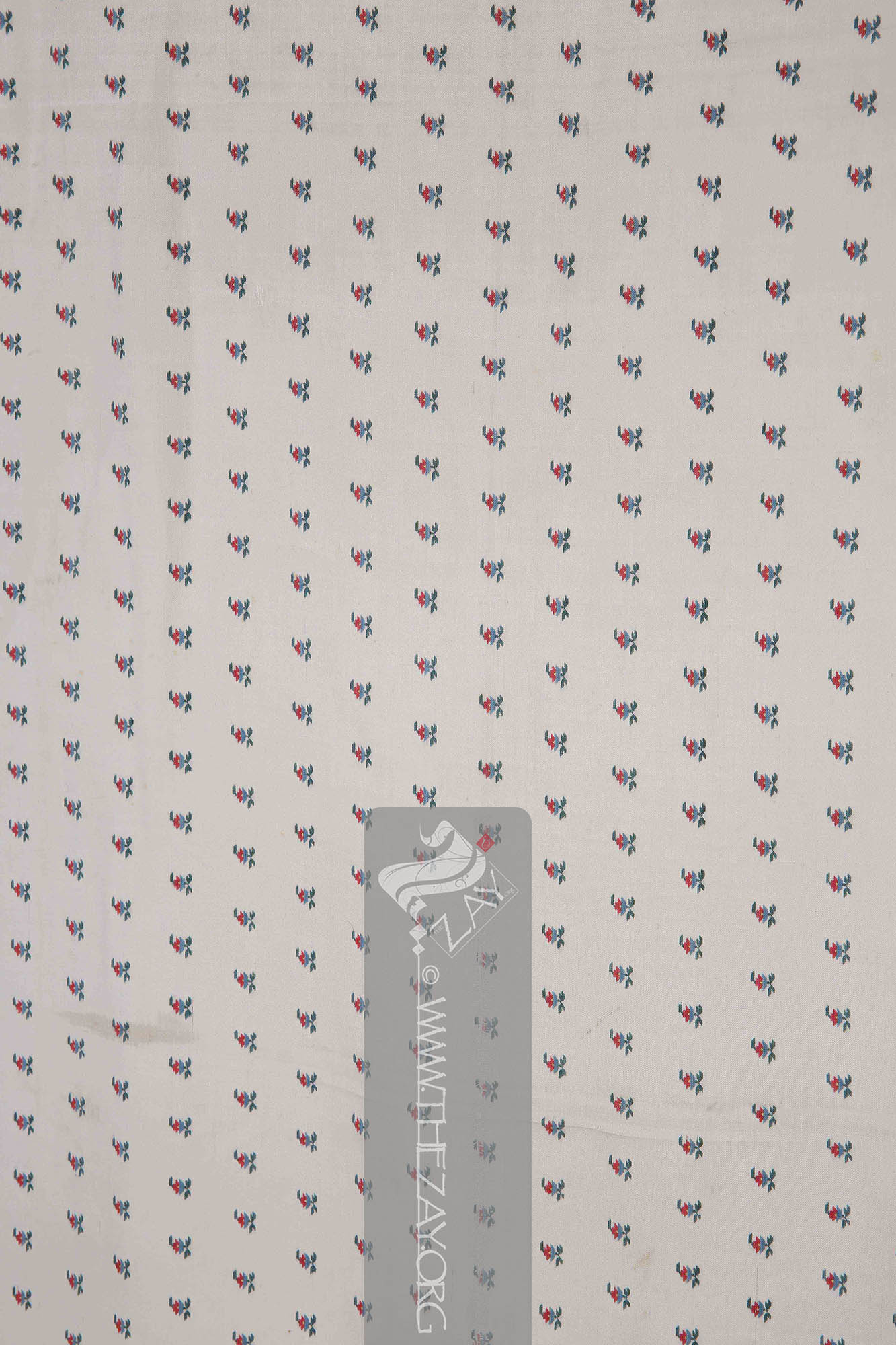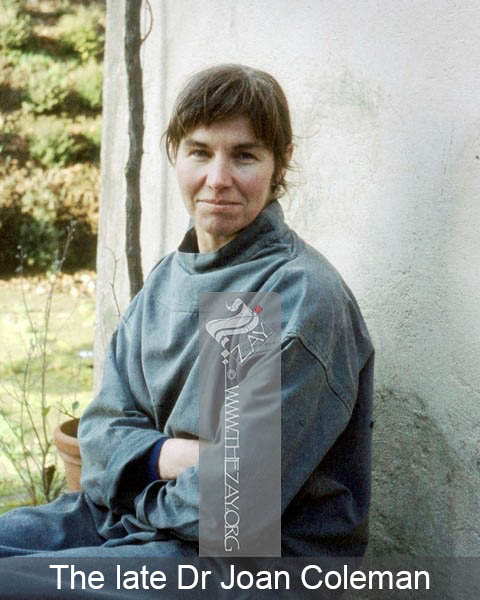Object HistoryThis
satin
Sātin: (Arabic: Zaytuni: from Chinese port of Zayton in Quanzhou province where it was exported from and acquired by Arab merchants), one of the three basic types of woven fabric with a glossy top surface and a dull back. Originated in China and was fundamentally woven in silk. square (
shawl
Shawl: (Persian: shāl from Hindi: duśālā – Shoulder Mantle), a shawl is a South Asian version of a scarf worn or wrapped loosely over the shoulders and is usually made of wool. ) dating back to the 19th century was originally a part of the Simeon Collection. It was purchased by Dr. Joan Coleman, at a Phillips auction on September 9, 1992. Later The
Zay
Zay: (Arabic: costume, Pl. azyaā’), a set of clothes in a style typical of a particular country or historical period. Initiative managed to acquire it from Kerry Taylor Auctions in 2020. This
shawl
Shawl: (Persian: shāl from Hindi: duśālā – Shoulder Mantle), a shawl is a South Asian version of a scarf worn or wrapped loosely over the shoulders and is usually made of wool. was part of a set of a trio at the Dr Joan Coleman Collection alongside a brown silk square
shawl
Shawl: (Persian: shāl from Hindi: duśālā – Shoulder Mantle), a shawl is a South Asian version of a scarf worn or wrapped loosely over the shoulders and is usually made of wool. (
ZI2020.500759 EUROPE) which is also a part of The
Zay
Zay: (Arabic: costume, Pl. azyaā’), a set of clothes in a style typical of a particular country or historical period. Initiative collection.
Dr Joan Coleman began collecting shawls in 1976 and developed her lifelong passion for collecting. She was a regular at the London salesrooms of Christie’s, Sotheby’s, and Phillips – three of the most outstanding auction houses of the period in the world – getting to know the dealers and learning in the process. She acquired vast knowledge and dedicated hours carefully cataloguing her ever-growing collection. She intended to loan her collection to different museums and institutions for the benefit of learning and education. Her collection is one of the largest and the finest private
shawl
Shawl: (Persian: shāl from Hindi: duśālā – Shoulder Mantle), a shawl is a South Asian version of a scarf worn or wrapped loosely over the shoulders and is usually made of wool. collections to have ever graced the world with shawls ranging from Kashmir,
Paisley
Paisley: (Scottish Gaelic, Pàislig: a town in Scotland), often called buta, boteh, amli, or kalgi in the subcontinent and kazuwah in Arabic, is a Persian tear drop motif with a curved end specially in textiles. Its popularity and subsequent local production in 18th century at Paisley are responsible for its nomenclature., Edinburgh, Norwich, France, and Iran.
Object Features This ivory square silk
shawl
Shawl: (Persian: shāl from Hindi: duśālā – Shoulder Mantle), a shawl is a South Asian version of a scarf worn or wrapped loosely over the shoulders and is usually made of wool. of (
satin
Sātin: (Arabic: Zaytuni: from Chinese port of Zayton in Quanzhou province where it was exported from and acquired by Arab merchants), one of the three basic types of woven fabric with a glossy top surface and a dull back. Originated in China and was fundamentally woven in silk.) weave was manufactured in Norwich c. 1820. At first glance, this
shawl
Shawl: (Persian: shāl from Hindi: duśālā – Shoulder Mantle), a shawl is a South Asian version of a scarf worn or wrapped loosely over the shoulders and is usually made of wool. draws one’s eyes with its simplicity and elegance. The entire body of the
shawl
Shawl: (Persian: shāl from Hindi: duśālā – Shoulder Mantle), a shawl is a South Asian version of a scarf worn or wrapped loosely over the shoulders and is usually made of wool. is sprinkled with several tiny floral sprig motifs with a red flower. These motifs are equally distributed across the field of the
shawl
Shawl: (Persian: shāl from Hindi: duśālā – Shoulder Mantle), a shawl is a South Asian version of a scarf worn or wrapped loosely over the shoulders and is usually made of wool. . It has a border that was separately woven in wool and stitched to the body. The border has three layers – a thick frame sandwiched between two thin similar looking frames.
The thicker frame is composed of stylized and tilted leaf scrolls and other floral motifs in gold, pink, blue, and black wool. The two thinner frames are composed of foliage arranged around a central wavy vine in gold, pink and black. The fringed tassels beyond the borders all around the
shawl
Shawl: (Persian: shāl from Hindi: duśālā – Shoulder Mantle), a shawl is a South Asian version of a scarf worn or wrapped loosely over the shoulders and is usually made of wool. enhance its delicacy and finesse.
There are quite a few traces of darning across the field and around the border that further proves its fragility and bear testament to its usage over the years. The masterful darning possibly with
satin
Sātin: (Arabic: Zaytuni: from Chinese port of Zayton in Quanzhou province where it was exported from and acquired by Arab merchants), one of the three basic types of woven fabric with a glossy top surface and a dull back. Originated in China and was fundamentally woven in silk. threads that escapes notice at a glance suggests that it was done by a pair of extremely skilful hands and the piece was perhaps valued by its owner.
The attachment of the border to the body of the
shawl
Shawl: (Persian: shāl from Hindi: duśālā – Shoulder Mantle), a shawl is a South Asian version of a scarf worn or wrapped loosely over the shoulders and is usually made of wool. as well as the tiny floral sprig motifs woven into the body proofs that it was woven using a (
draw_loom
Draw_loom: (English) It is a type of weaving apparatus that enables complex patterns to be woven into textiles. It uses a system of cords and pulleys to control the warp
Warp: One of the two basic components used in weaving which transforms thread or yarns to a piece of fabric. The warp is the set of yarns stretched longitudinally in place on a loom before the weft
Weft: one of the two basic components used in weaving that transforms thread or yarns into a piece of fabric. It is the crosswise thread on a loom that is passed over and under the warp threads. is introduced during the weaving process. threads, allowing individual threads to be lifted and lowered to create intricate designs.). Square shawls like this were usually folded diagonally in half and were often draped around the shoulders and were popular fashionable accessories in the first quarter of the 19th century perhaps because they complemented the silhouettes that were transitioning from (
mantua
Mantua: (French: manteau – Coat or mantle; or Mantua – an Italian city known for expensive silk), women’s garments in the late 17th and 18th centuries – Baroque period – characterized by flowing skirts with elaborate trains. It was popularized by Queen Mary II of England into a symbol of aristocracy.) and (
pannier
Pannier: (Latin: panarium – breadbasket), originated at the 17th century Spanish court were accessories for women's dresses that extended the width of the skirts on the sides providing a panel to display elaborate decorations – embroidery, weaves, and prints. It was inspired by the the baskets carried by beasts of burden for transporting goods.) to dress with (
empire_waistline
Empire_Waistline: (Synonyms: Empire silhouette/line/waist, Empire), is a style of dress where the waistline is raised to just below the bust. Popularized by Empress Josephine in the early 19th century, it began as a part of Neoclassical fashion reviving Greco-Roman style of wearing loose rectangular tunics that were belted under the bust.).




